GE PSKP333EBWW, PCKS443EBWW, PSKS333EBWW INSTALLATION INSTRUCTIONS AND OPERATION MANUAL
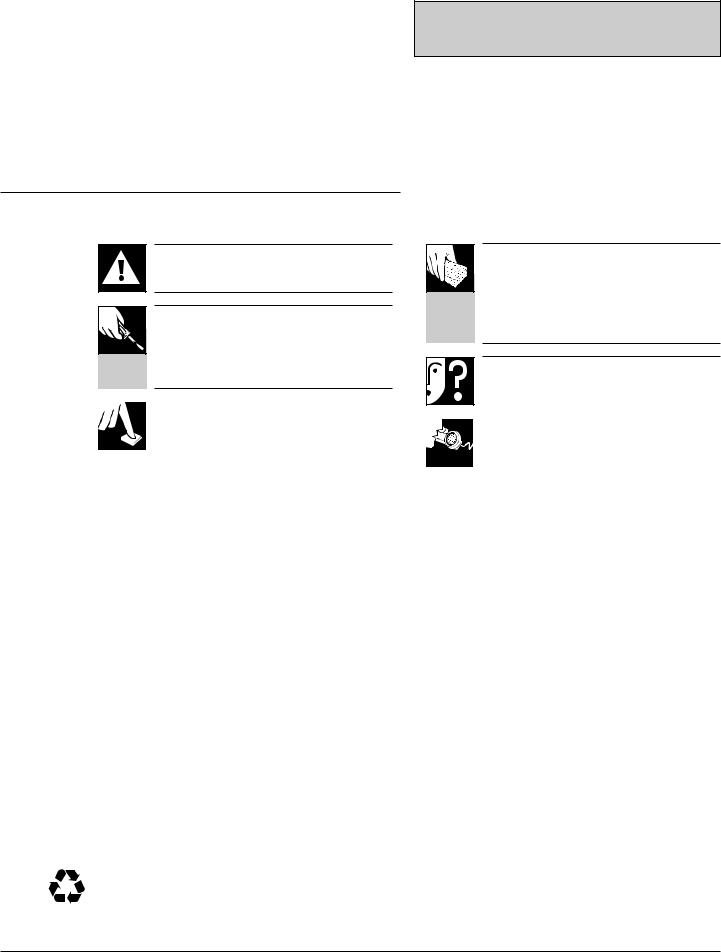
UseandCare Guide
With Installation Instructions
Dryer
Safety Instructions................... |
3, 4 |
Installation Instructions |
|
Exhaust......................................................... |
5, 6 |
Electric Dryer ................................................... |
7 |
Care and Cleaning |
|
Dryer Exhaust ............................................... |
13 |
Exterior ........................................................... |
12 |
Lint Filter ........................................................ |
12 |
Problem Solver ............................. |
14 |
|
|
Operating Instructions, Tips |
|
|
|
|
|
|
|
|
|
|
|
|
|||
|
|
|
|
Consumer Services |
|
|||
|
|
|
|
|||||
|
|
Automatic Drying |
10, 11 |
|
|
|
|
|
|
|
|
|
|
|
|||
|
|
|||||||
|
|
Drying Selection Guide |
10 |
|
|
|
Model and Serial Numbers |
2 |
|
|
|
|
|
||||
|
|
Knits Drying Tips.............................. |
8, 10, 14 |
|
|
|
Repair Service ................................................. |
2 |
|
|
Lint Filter ........................................................ |
12 |
|
|
|
Warranty ........................................................ |
16 |
|
|
Loading |
9 |
|
|
|
|
|
|
|
|
|
www.geappliances.ca |
|
|||
|
|
Operating the Dryer |
8, 9 |
|
|
|
||
|
|
|
|
|
|
|
||
|
|
Permanent Press |
|
|
|
|
|
|
|
|
Drying Tips ......................................... |
10, 14 |
|
|
|
|
|
|
|
Sorting Clothes |
9, 10 |
|
|
|
|
|
|
|
|
|
|
For service call: |
|
||
|
|
Special Instructions |
10, 11 |
|
|
|
|
|
|
|
|
1-800-361-3400 |
|
||||
|
|
Timed Drying ................................................ |
11 |
|
|
|||
|
|
|
|
|
|
|
|
|
RECYCLED PAPER
RECYCLABLE
We care about our environment
500A307P005
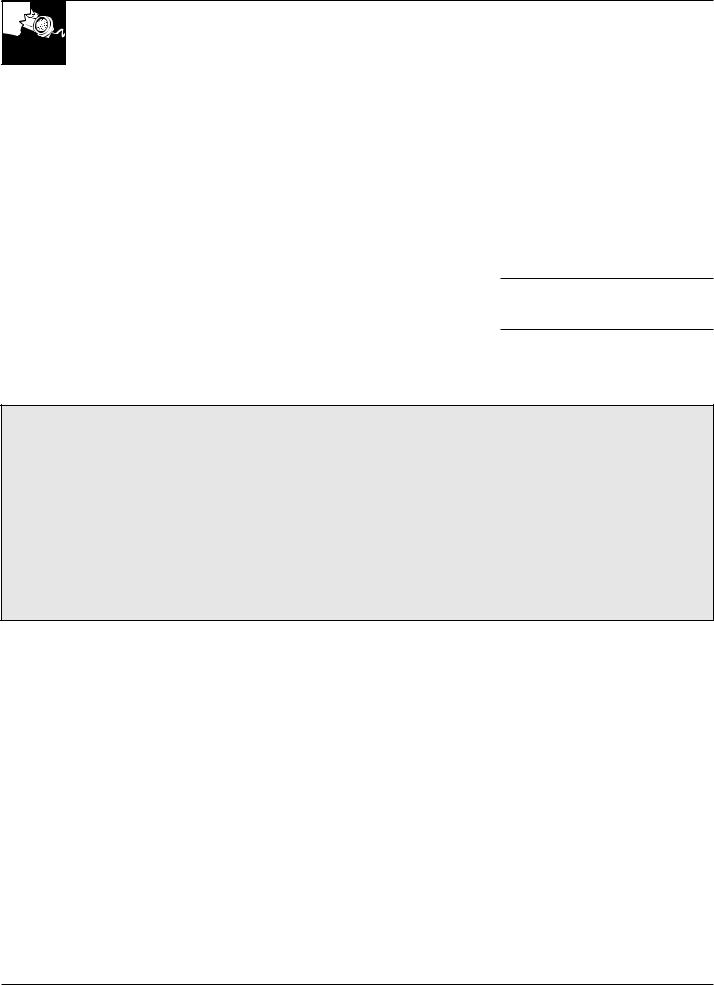
HELP US HELP YOU
Read this book carefully.
It is intended to help you operate and maintain your new dryer properly.
Keep it handy for answers to your questions.
If you don’t understand something or need more help, write (include your phone number)
Consumer Relations Manager
Camco Inc.
1 Factory Lane, Suite 310
Moncton, N.B. E1C 9M3
Save time and money.
Before you request service...
check the Problem Solver section, it lists causes of minor operating problems that you can correct yourself.
If you received a
damaged dryer...
Immediately contact the dealer (or builder) that sold you the dryer.
Write down the model and serial numbers.
You’ll find them on a label on the front of the dryer behind the door.
These numbers are also on the Consumer Product Ownership Registration Card that came with your dryer. Before sending in this card, please write these numbers here:
Model Number
Serial Number
Use these numbers in any correspondence or service calls concerning your dryer.
WARNING: For your safety the information in this manual must be followed to minimize the risk of fire or explosion or to prevent property damage, personal injury or death.
–Do not store or use gasoline or other flammable vapors and liquids in the vicinity of this or any other appliance.
–WHAT TO DO IF YOU SMELL GAS
•Do not try to light any appliance.
•Do not touch any electrical switch;
do not use any phone in your building.
•Clear the room, building or area of all occupants.
•Immediately call your gas supplier from a neighbor’s phone. Follow the gas supplier’s instructions.
•If you cannot reach your gas supplier, call the fire department.
–Installation and service must be performed by a qualified installer, service agency, or the gas supplier.
IF YOU NEED SERVICE...
Please Call: 1-800-361-3400
Camco Service Contracts
Your new dryer is a well designed and engineered product. Before it left the factory, it went through rigorous tests, just to make sure it was as problem-free as possible. And you have a warranty to protect you against manufacturing problems during the period of your dryer warranty.
Camco Service Contracts are available to provide the same trouble-free service for as long as you own your appliance. Should your appliance require service after the warranty has expired, a Camco Service Contract takes care of any repairs your appliance needs – both parts and labour.
For further information, call 1-800-461-3636.
Satisfied with Service...
We want you to be satisfied with our service. If you have reason to be concerned with the service you received on your appliance, please phone:
1-800-361-3400,or write to
Consumer Relations Manager, Camco Inc.
1 Factory Lane, Suite 310
Moncton, N.B. E1C 9M3
Please include all the details, such as model, serial number, date of purchase, as well as your phone number, in any correspondence.
2
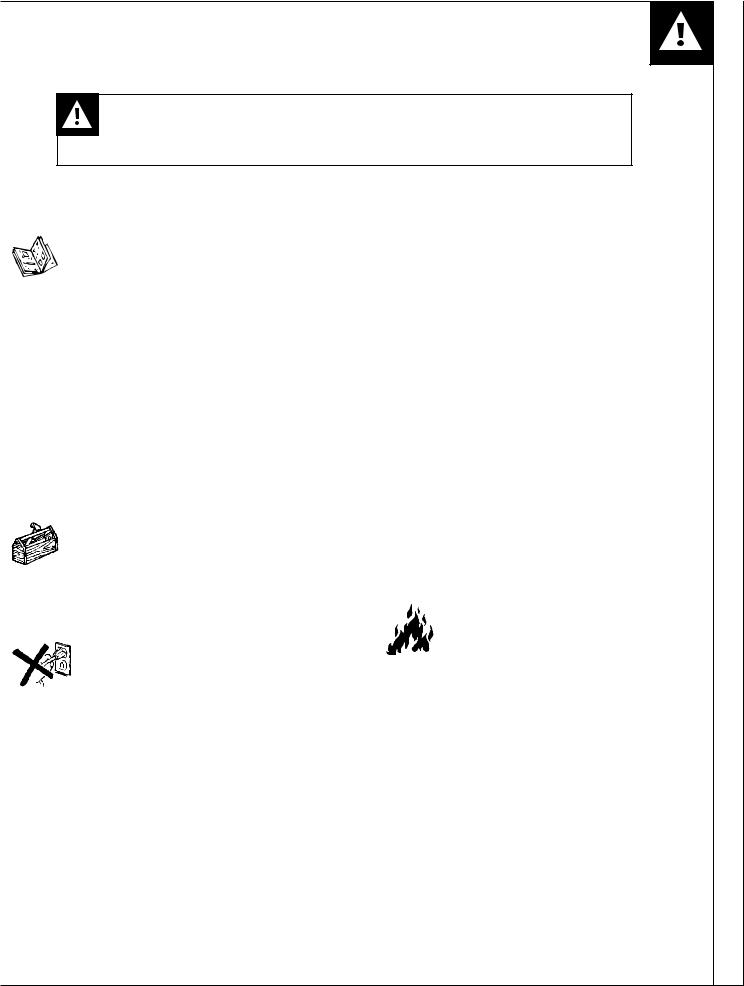
IMPORTANT SAFETY INSTRUCTIONS
Read all instructions before using this appliance
Warning - It is extremely important that you read and adhere to the following instructions. Failure to do so could cause bodily injuries and / or property damage due to fire.
•Use this appliance only for its intended purpose as described in this Use and Care Book.
This dryer must be properly installed and located in accordance with the Installation Instructions before it is used.
–Properly ground to conform with Local Codes. Follow details in Installation Instructions.
–Locate where the temperature is above 50˚F. (10˚C.) for satisfactory operation of the dryer control system. Do not install or store the dryer where it will be exposed to the weather.
–Connect to a properly rated, protected and sized power supply circuit to avoid electrical overload.
–Exhausting to the outside is STRONGLY RECOMMENDED to prevent large amounts of moisture and lint from being blown into the room. Carefully follow the Exhausting Details in the Installation Instructions.
Do not repair or replace any part of the
appliance or attempt any servicing unless specifically recommended in this
Use and Care Book or in published user-repair instructions that you understand and have the skills to carry out.
When disconnecting this appliance
pull by the plug rather than the cord to avoid damage to the cord or junction of cord and plug. Make sure that the cord
is located so that it will not be stepped on, tripped over or otherwise subjected to damage or stress.
To Minimize the Possibility of a
Fire Hazard
•Exhaust Duct – See Installation Instructions. Use only rigid metal or flexible metal 4” diameter ductwork for exhausting to the outside. USE OF PLASTIC OR OTHER COMBUSTIBLE DUCTWORK CAN CAUSE A FIRE. FOIL OR OTHER EASILY PUNCTURED DUCTWORK CAN CAUSE A FIRE IF IT COLLAPSES OR BECOMES OTHERWISE RESTRICTED IN USE OR DURING INSTALLATION.
•Do not use heat to dry articles containing rubber, plastic, or similar materials (such as padded bras, tennis shoes, galoshes, bath mats, rugs, bibs, pillows, baby pants, plastic bags, etc.) as these materials may melt or burn. Also, some rubber materials, when heated, can under certain circumstances produce fire by spontaneous combustion.
•Do not store items that may burn or melt (such as clothing, paper material, plastics or plastic containers, etc.) on top of the dryer during the operation.
•Garments labeled “Dry Away from Heat” (such as life jackets containing Kapok or foam) must not be put in your dryer.
• Do not wash or dry articles that
have been cleaned in, washed in, soaked in, or spotted with combustible or explosive substances (such as wax, paint, gasoline degreasers, dry-
cleaning solvents, kerosene, etc.) which may ignite or explode. Do not add these substances to the wash water. Do not use these substances around your washer and/or dryer during operation.
•Any article on which you have used a cleaning solvent, or which contains flammable materials (such as cleaning cloths, mops, towels used in beauty salons, restaurants or barber shops, etc.) must not be placed in or near the dryer until all traces of these flammable liquids or solids and their fumes have been removed. There are many highly flammable items used in homes such as: acetone, denatured alcohol, gasoline, kerosene, some household cleaners, some spot removers, turpentines, waxes, wax removers and products containing petroleum distillates.
(continued on next page)
3
<![endif]>Instructions Safety Important
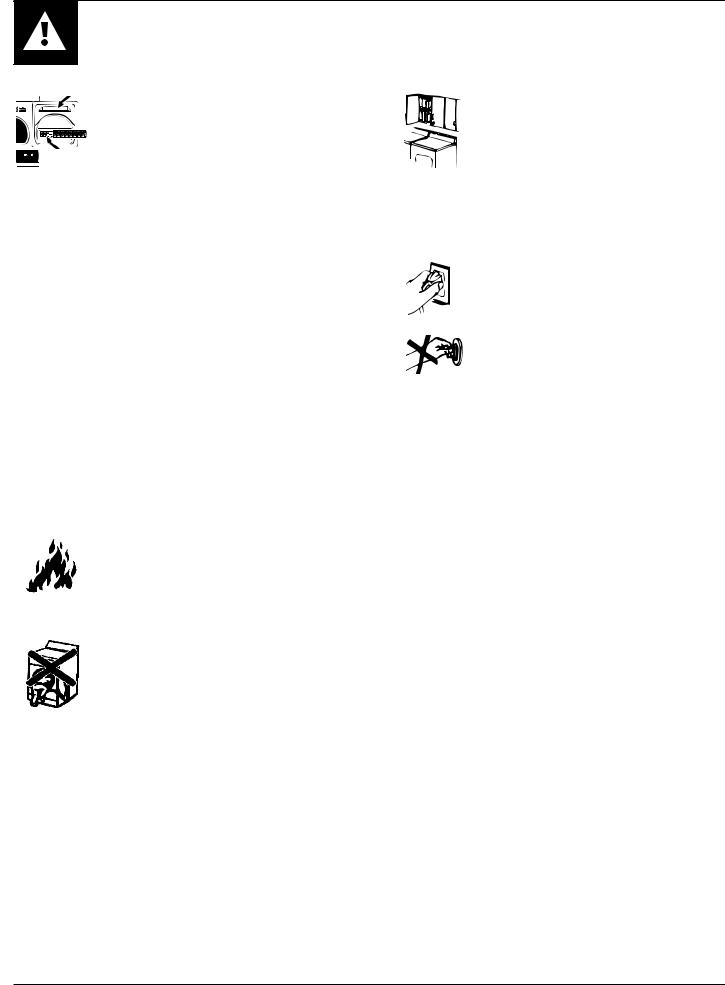
IMPORTANT SAFETY INSTRUCTIONS
•Clean the lint filter before each load to prevent lint accumulation inside the dryer or in the room.
DO NOT OPERATE THE DRYER WITHOUT THE LINT FILTER IN PLACE.
•Keep the area around the exhaust opening, and around and underneath your appliances free from the accumulation of combustible materials, such as lint, paper, rags, chemicals, etc.
•Regularly inspect the exhaust duct to be sure it has not been crushed or otherwise restricted.
•The interior of the dryer cabinet and the exhaust duct connection inside the dryer should be cleaned every 2 to 3 years, or more often if needed, by a qualified service person. (see Care & Cleaning section)
To Minimize the Possibility of Injury
•Never reach into the dryer while the drum is moving. Before loading, unloading or adding clothes, wait until the drum has completely stopped.
•Do not dry fiberglass articles in your dryer. Skin irritation could result from the remaining glass particles that may be picked up by clothing during subsequent dryer uses.
• The laundry process can reduce the flame retardance of fabrics. To avoid such a result, the garment manufacturer’s care instructions should be followed very carefully.
• Close supervision is necessary if this
appliance is used by or near children.
Do not allow children to play inside,
on, or with this appliance or any
discarded appliance. Dispose of discarded appliances and shipping or
packing materials properly. Before discarding a dryer, or removing from service, remove the door of the dryer compartment.
SAVE THESE
INSTRUCTIONS
• Keep all laundry aids (such as detergents, bleaches, fabric softeners, etc.) out of the reach of children, preferably in a locked cabinet. Observe all warnings on container labels to avoid personal injury.
•Keep the floor around your appliances clean and dry to reduce the possibility of slipping.
•To minimize the possibility of electric shock,
unplug this appliance from the power supply before attempting any maintenance or cleaning (except the removal and cleaning of the lint filter).
• NOTE: Turning the Cycle Selector knob to an OFF position does NOT disconnect the appliance from the power supply.
•Do not tamper with the controls.
•Do not operate this appliance if it is damaged, malfunctioning, partially disassembled, or has missing or broken parts, including a damaged cord or plug.
•Never climb on or stand on the dryer top.
•DO NOT place items exposed to cooking oils in your dryer. Items contaminated with cooking oils may contribute to a chemical reaction that could cause a clothes load to catch fire.
•If yours is a gas dryer, it is equipped with an automatic electric ignition and does not have a pilot light. DO NOT ATTEMPT TO LIGHT WITH A MATCH. Burns may result from having your hand in the vicinity of the burner when the automatic ignition may turn on.
Dryer-applied Fabric Softeners or Anti-static Conditioners
You may wish to soften your laundered fabrics or reduce the static electricity in them. We recommend you use either a fabric softener in the wash cycle, according to the manufacturer’s instructions for those products, or try a dryer-added product for which the manufacturer gives written assurance on the package that their product can be safely used in your dryer.
Service or performance problems caused by the use of these products are the responsibility of the manufacturers of those products and are not covered under the warranty of this appliance.
4

INSTALLATION INSTRUCTIONS
EXHAUST
Installation and service must be performed by a qualified installer, service agency or the gas supplier. IMPORTANT: Have your dryer installed properly.
NOTE: The WARNING and IMPORTANT instructions appearing in this manual are not meant to cover all possible conditions and situations that may occur. It must be understood that common sense, caution, and carefulness are factors that CANNOT be built into the dryer. These factors MUST BE supplied by the person(s) installing, maintaining, or operating the dryer.
Failure to install, maintain, and/or operate this machine according to the manufacturer’s instructions may result in conditions which can produce bodily injury and/or property damage.
This dryer comes ready for top exhausting.
WARNINGS
•DO NOT USE NON METALLIC FLEXIBLE DUCT.
•Never use flexible duct inside the dryer.
•Do not terminate exhaust in a chimney, range hood, gas vent, floor or attic. The combination of lint and grease could create a fire hazard or damages.
•Provide an access for inspection and cleaning the exhaust system at least once a year. (See Care and Cleaning Section.)
EXHAUST LENGTH
The MAXIMUM ALLOWABLE length of the exhaust system depends upon the type of duct, number of turns, the type of exhaust hood (wall cap), and all conditions noted below. The maximum allowable length for both rigid and flexible metal duct is shown in the table 1 (next page). More than four 90˚ turns is not recommended.
EXHAUST SYSTEM CHECK LIST HOOD or WALL CAP
•Terminate in a manner to prevent back drafts or entry of birds or other wildlife.
•Termination should present minimal resistance to the exhaust air flow and should require little or no maintenance to prevent clogging.
•Wall caps must be installed at least 300 mm (12”) above ground level or any other obstruction with the opening pointed down.
•If roof vents or louvered plenums are used, they must be equivalent to a 100 mm (4”) dampered wall cap in regard to resistance to air flow, prevention of back drafts and maintenance required to prevent clogging.
SEPARATION OF TURNS
Separate all turns by at least 1 m (3 ft.) of straight duct, including distance between last turn and dampered wall cap. If two turns must be closer than 1 m (3 ft.) deduct 3 m (10 ft.) from the maximum lengths shown in the table for each occurrence.
TURNS OTHER THAN 90˚
•One turn of 45˚ or less may be ignored.
•Two 45˚ turns should be treated as one 90˚.
•Each turn over 45˚ should be treated as one 90˚.
SEALING OF JOINTS
•All joints should be tight to avoid leaks. The male end of each section of duct must point away from the dryer.
•Do not assemble the duct work with fasteners that extend into the duct. They will serve as a collection point for lint.
•Duct joints can be made air and moisture-tight by wrapping the overlapped joints with duct tape.
INSULATION
•Duct work which runs through an unheated area or is near an air conditioning duct, should be insulated to reduce condensation and lint build up and be sloped down toward outdoors.
NOTE: Never install screen inside exhaust duct.
WARNING: THE DRYER MUST EXHAUST TO THE OUTDOORS.
TO PREVENT LARGE AMOUNTS OF LINT AND MOISTURE FROM ACCUMULATING AND TO MAINTAIN DRYING EFFICIENCY, THIS MACHINE MUST BE EXHAUSTED OUTDOORS.
5
<![endif]>Exhaust Instructions Installation
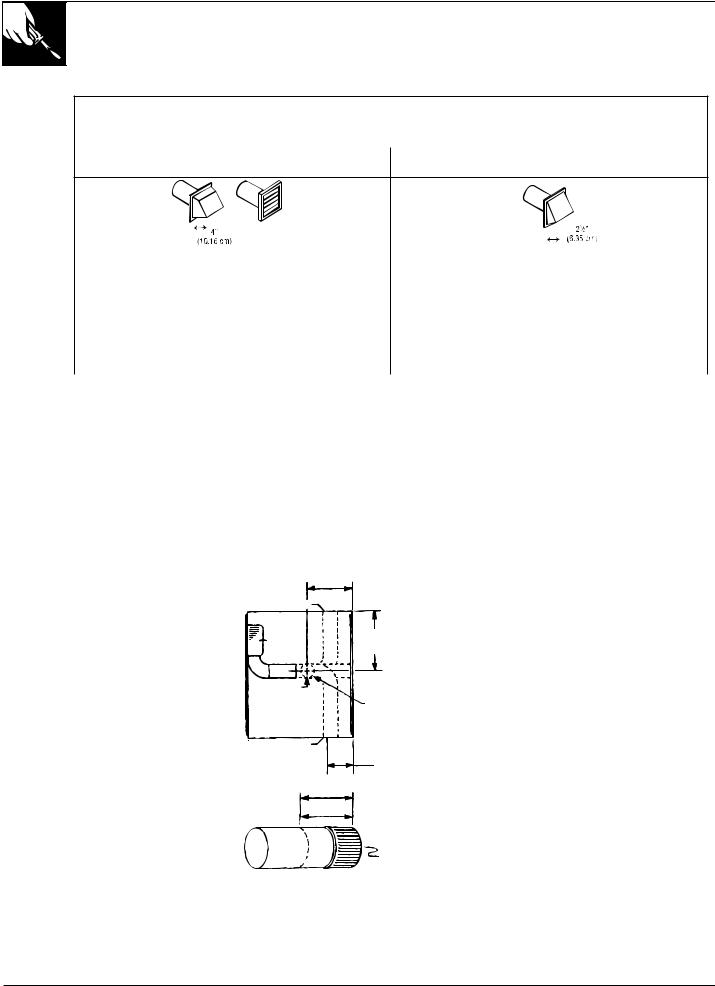
EXHAUST LENGTH CALCULATION
Table 1: RECOMMENDED MAXIMUM LENGTH
|
ELECTRIC DRYERS |
|
|
|
Weather Hood Type |
|
|
Recommended |
Use only for short |
|
run installations |
No. of 90˚ |
Rigid |
Metallic |
Rigid |
Metallic |
elbows |
|
Flexible* |
|
Flexible* |
|
|
|
|
|
0 |
14 m (46 ft.) |
9 m (30 ft.) |
11 m (37 ft.) |
7 m (24 ft.) |
1 |
11 m (38 ft.) |
7.5 m (25 ft.) |
9 m (30 ft.) |
6 m (20 ft.) |
2 |
9 m (31 ft.) |
6 m (20 ft.) |
6.5 m (22 ft.) |
4 m (14 ft.) |
3 |
7 m (24 ft.) |
5 m (16 ft.) |
4.5 m (15 ft.) |
3 m (10 ft.) |
|
|
|
|
|
* Do not use non metallic flexible duct.
ALTERNATE EXHAUST DIRECTIONS
IF YOUR DRYER COMES WITH REAR EXHAUST, TO CHANGE TO SIDE OR DOWN EXHAUST:
•Remove access panel at back of dryer to gain access to internal ducts.
•Disconnect duct exhaust from blower housing (remove tape securing duct).
FOR SIDE EXHAUST:
•Remove desired knockout plate (either right or left side).
•Cut a 115 mm (4 1/2”) length of 100 mm (4”) dia. rigid duct as
shown (remove burrs from cut edge).
•Attach this extension duct to blower housing duct.
•Attach a 90˚ elbow facing desired opening.
•Attach a section of 100 mm (4”) dia. rigid duct to elbow to protrude thru side of cabinet.
•Seal all joints with duct tape.
•Reinstall rear access panel.
FOR BOTTOM EXHAUST:
•Remove cover plate at bottom of dryer.
•Install a 90˚ elbow.
•Seal all joints with duct tape.
•Reinstall rear access panel.
•Place cover plate (removed from bottom of dryer) over rear exhaust opening.
152 mm
6"
Left knockout
Blower
<![if ! IE]><![endif]>Front of dryer
Right knockout
295 mm (115/8")
115 mm (41/2")
 Cut Here
Cut Here
EXTENSION DUCT
IF YOUR DRYER COMES WITH TOP EXHAUSTING, TO CHANGE TO SIDE OR REAR EXHAUST:
•Remove rear access panel.
•Disconnect retaining plate & 90˚ elbow by removing mounting screw from the chassis & remove tape securing elbow to blower housing.
•Remove cover plate from rear access panel and place over top exhaust opening.
203 mm (8")
Bottom knockout
89 mm (31/2")
 For Rear Exhaust
For Rear Exhaust
 For Side Exhaust
For Side Exhaust
Rigid
Metallic
Ducting
FOR SIDE EXHAUST:
•Remove retaining plate attached to 90˚ elbow.
•Remove desired knockout plate (either right or left side).
•Cut a 115 mm (4 1/2”) length of 100 mm (4”) dia. rigid duct as shown (remove burrs from cut edge).
•Attach this extension duct to blower housing duct.
•Attach the 90˚ elbow facing desired opening.
•Attach a section of 100 mm (4”) dia. rigid duct to elbow to protude thru side of cabinet.
•Seal all joints with duct tape.
•Reinstall rear access panel.
FOR REAR EXHAUST:
•Cut a 295 mm (11 5/8”) length of 100 mm (4”) dia. ridig duct as shown (remove burrs from cutting edge).
•Attach this extension duct to blower housing.
•Seal all joints with duct tape.
•Reinstall rear access panel.
NOTE: Non-metallic ducts must never be used inside dryer cabinet.
6
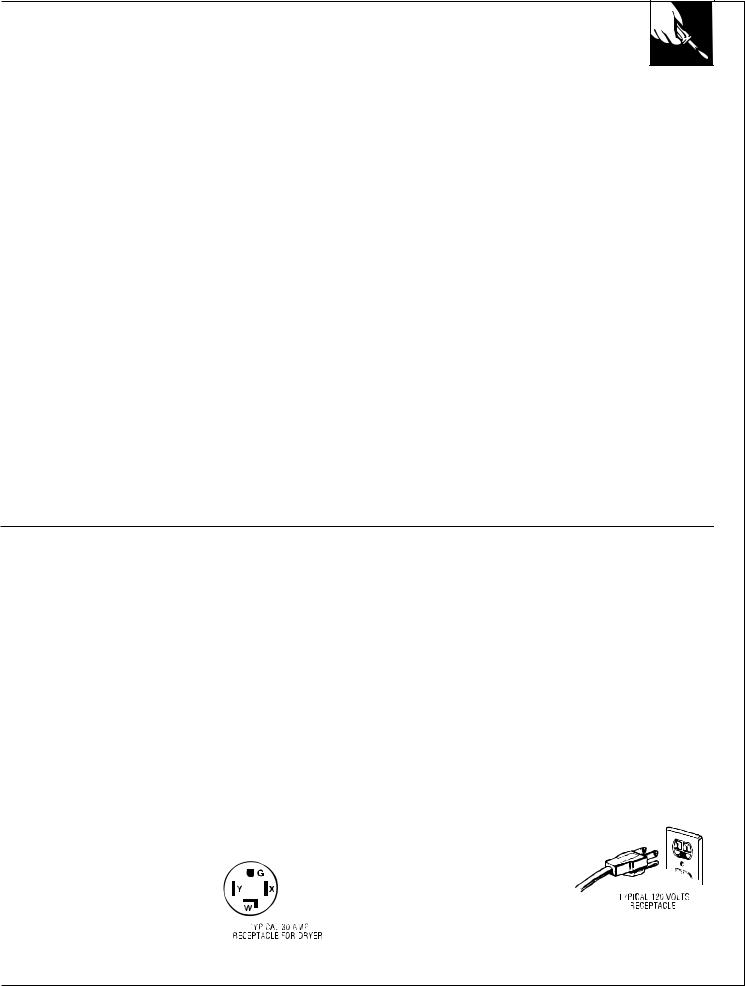
INSTALLATION
IMPORTANT - OBSERVE ALL GOVERNING CODES
Dryer must be levelled and rest firmly on the floor. WARNING: THE 208/240V DRYER MUST BE INSTALLED WITH
CONTROL PANEL AT BOTTOM IN ORDER TO OPERATE ADEQUATELY
SPECIAL INSTALLATION REQUIREMENTS
ALCOVE OR CLOSET INSTALLATION
•WARNING: To reduce the risk of fire, this dryer MUST BE EXHAUSTED TO THE OUTDOORS. See EXHAUST INFORMATION section.
•Minimum clearances between dryer cabinet and adjacent walls or other surfaces are:
0” either side 1” front and rear
•Minimum vertical space from floor to overhead cabinets, ceilings, etc. is 52”.
•Closet door must be louvered or otherwise ventilated and must contain a minimum of 60 sq. in. of open area equally distributed. If this closet contains both a washer and a dryer, doors must contain a minimum of 120 sq. in. of open area equally distributed.
•No other fuel-burning appliance shall be installed in the same closet with the dryer.
MINIMUM CLEARANCES OTHER THAN ALCOVE OR CLOSET INSTALLATIONS.
•Minimum clearances to combustible surfaces: 0 clearance both sides and 25 mm (1”) rear.
MOBILE HOME INSTALLATION
•The dryer must be exhausted to the outdoors with the termination securely fastened to the mobile home structure. (See EXHAUST INFORMATION section.)
•The exhaust MUST NOT be terminated beneath the mobile home.
•Provisions must be made for the introduction of outside air into the dryer. The free air opening shall not be less than 80 cm2 (12 in2).
•The exhaust duct material MUST BE METAL.
•The dryer must be attached to the floor following instructions available from the dealer.
•Installation must comply with the current CAN/CSA Z240 MH series Mobile Home Installation Codes.
NOTE: CONSIDERATION MUST BE GIVEN TO INSTALLING AND SERVICING THE APPLIANCE.
ELECTRICAL POWER SUPPLY
CAUTION: NEVER USE AN EXTENSION CORD WITH THIS APPLIANCE.
•This dryer must be connected to an individual circuit identical to the one specified on the rating plate of the loading port, protected by fuses or circuit breaker conforming to local codes. THIS APPLIANCE MUST BE PROPERLY GROUNDED.
•The power cord of this appliance is equipped with a three (3) or four (4) prong plug which mates with an appropriate dryer wall receptacle.
GROUNDING INSTRUCTIONS
•This appliance must be grounded. In the event of malfunction or breakdown, grounding will reduce the risk of electric shock by providing a path of least
resistance for electric current. The plug must be plugged into an appropriate outlet that is properly installed and grounded in accordance with all local codes and ordinances.\
WARNING:
•Improper connection of the equipment grounding conductor can result in a risk of electric shock. Check with a qualified electrician or serviceman if you are in doubt as to whether the appliance is properly grounded.
•Do not modify the plug provided with the appliance
– if it will not fit the outlet, have a proper outlet installed by a qualified electrician.
Note: If the electrical power supply provided does not meet the specifications listed below, call a licensed electrician.
FOR 120/240 V DRYERS, POWER SUPPLY...
1.Must be of 120/240 volts or 120/208 volts, 60 Hz circuit with wall receptacle as
shown beside.
2. Must be protected with 30A FUSES OR BREAKERS.
3. Must be WELL GROUNDED.
4. Must CONFORM TO LOCAL CODES.
FOR 120V DRYERS, POWER SUPPLY...
1. Must be of 120 volts, 60 Hz
circuit with wall receptacle as shown beside.
2. Must be protected with 15 or 20A FUSES OR BREAKER.
3. Must be WELL GROUNDED.
4.Installation must be in accordance
with the current CSA C22.1 Canadian Electrical code part 1 and/or local codes.
7
<![endif]>Installation
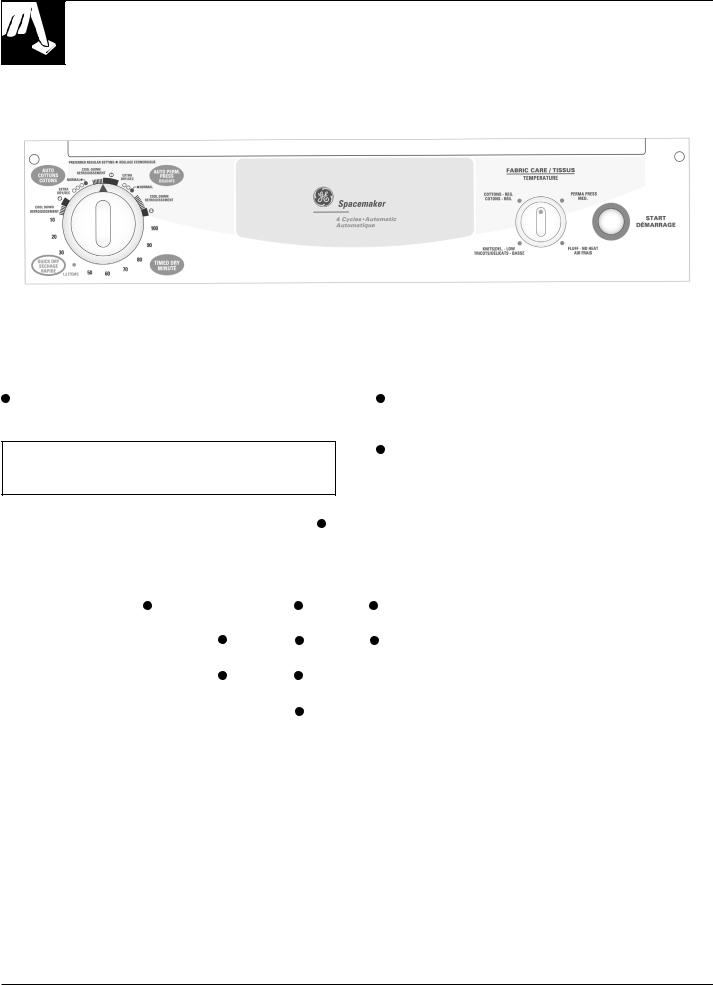
OPERATING YOUR DRYER
WARNING – To reduce the risk of fire, electric shock, or injury to persons when using your appliance read the IMPORTANT SAFETY INSTRUCTIONS before operating this appliance.
Features and appearances may vary
1Drying Selections. Select the proper heat on the Fabric Care selector for your load.
NOTE: Drying times will vary according to the size of load, types of fabrics, wetness of clothes, and condition of exhaust ducts.
2Cycle Selector. Turn the Cycle Selector to the desired cycle setting. The selector may be turned in either direction.
3Start. Push the Start button to start the dryer. (Opening the door during operation stops the dryer. To restart, close the door and follow above directions.)
|
Should be used with cycles indicated |
|
||
|
|
|
|
|
Drying |
Auto |
Auto |
|
Quick Dry |
Selections |
Cottons |
Perm. |
Timed Dry |
Sechage |
|
Cotons |
Press |
Minute |
Rapide |
|
|
|
|
|
Cottons Reg |
|
|
|
|
Cotons-Reg |
|
|
|
|
|
|
|
|
|
Perma Press |
|
|
|
|
Med |
|
|
|
|
Knits/Del-Low |
|
|
|
|
Tricots/Del.Basse |
|
|
|
|
|
|
|
|
|
Fluff-No Heat |
|
|
|
|
Air Frais |
|
|
|
|
|
|
|
|
|
* Fluff-No Heat option can be used with an automatic cycle, but for best performance it is recommended to be used with a timed cycle.
8
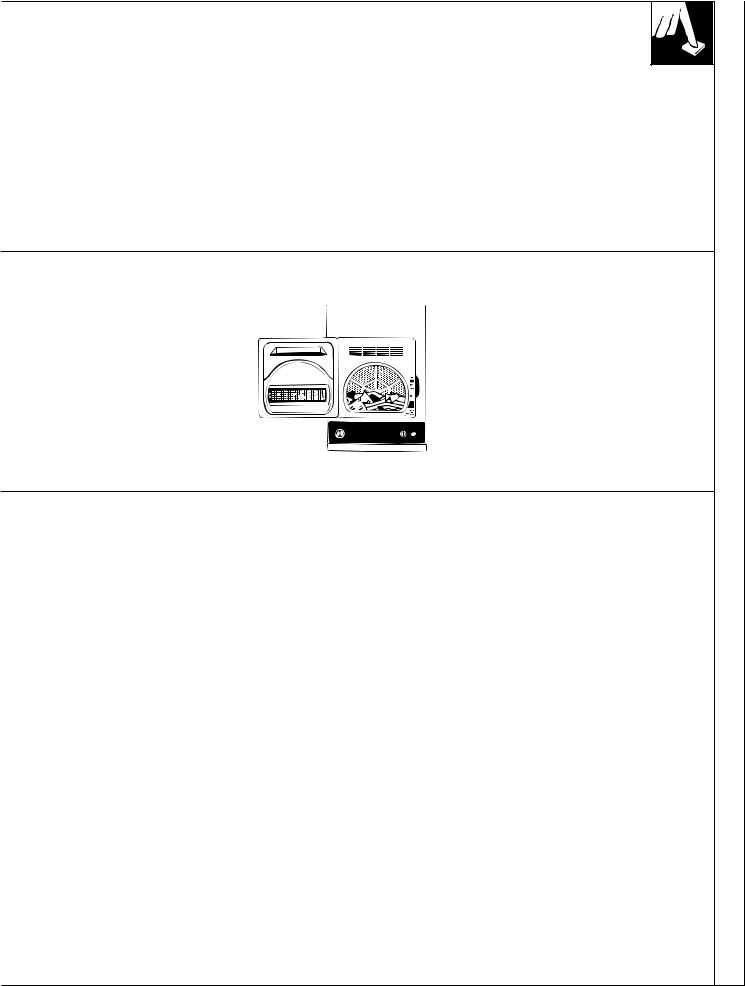
OPERATING YOUR DRYER
Polyester Knits & Permanent Press Drying Tips
•DO NOT OVERLOAD- |
•REMOVE CLOTHES |
•PLACE ON HANGERS- |
Garments being dried or |
PROMPTLY- |
Permanent press and polyester |
dewrinkled should tumble freely. |
To help prevent wrinkling, |
knit garments look best if placed |
|
remove clothes from the dryer |
on hangers after drying. |
|
promptly at the end of the drying |
|
|
cycles. |
|
HOW TO LOAD THE CLOTHES
Don’t overload your dryer. Crowded |
A large load will take a “LOT MORE |
loads don’t dry efficiently and clothes |
TIME” to dry. For quicker drying |
may be unnecessarily wrinkled. Loads |
separate a large or heavy load into a |
should look like this: |
normal load like this. |
HOW TO SORT CLOTHES
As a general rule, sort clothes by surface texture, fabric, colour and weight, as you would for your washer.
9
<![endif]>Dryer Your Operating
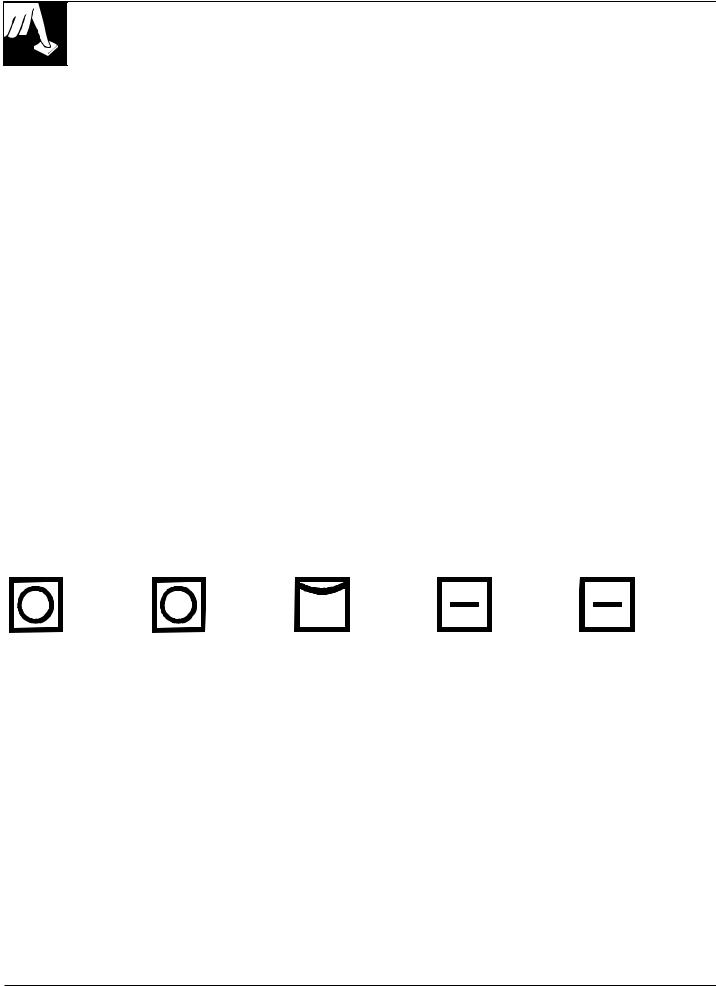
SUGGESTED FABRIC
AND DRYING SELECTIONS
Cycle Suggested |
For Clothes Load/Fabrics such as: |
Drying Selection |
|
|
|
Auto |
• Cottons and linens |
Cottons-Reg |
Cottons |
|
Cotons-Reg |
Cotons |
|
|
|
|
|
Auto Perm. |
• Permanent press fabrics with cotton |
Perma Press |
Press |
• Down-filled garments, if machine washing and |
Med |
|
|
|
|
drying is recommended |
|
|
• Synthetics |
|
|
|
|
Auto Perm |
• Silks and wools |
Knits/Del-Low |
Press |
• Rayon and acetate |
Tricots/Del. Basse |
With Extra Dry/Sec |
|
|
|
|
|
|
|
|
Timed Dry |
• Cotton |
Cottons or |
Minute |
Synthetics or Down |
Perma Press or |
|
• Large items |
Knits |
|
|
|
|
|
|
Quick Dry |
• 1 or 2 items (eg: soccer garment, school uniform) |
Cottons-Reg |
Sechage |
|
Cotons-Reg |
Rapide |
|
|
|
|
|
The terms High, Medium and Low Heat are those usually found on fabric care labels.
For best results, follow your fabric care labels.
|
MAY BE |
MAY BE |
SHOULD BE |
SHOULD BE |
SHOULD BE |
|
DRIED IN A |
DRIED IN A |
HUNG TO |
HUNG |
DRIED ON A |
|
TUMBLE |
TUMBLE |
DRY. |
SOAKING |
FLAT |
|
DRYER AT |
DRYER AT |
|
WET TO |
SURFACE. |
|
MEDIUM TO |
LOW |
|
DRIP DRY. |
|
|
REGULAR |
SETTING. |
|
|
|
(green) |
SETTING. |
(yellow) |
(green) |
(green) |
(yellow) |
|
10
